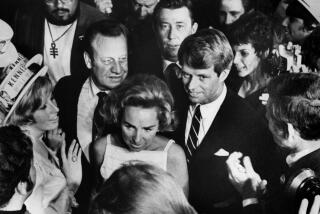The Carlyle Mystique
- Share via
The Kennedy mystique lives on at the Carlyle, the venerable hotel at Madison and 76th that served as the New York City White House when Jack Kennedy was President.
As I waited in the marble lobby I listened to a woman with a French accent. “I used to see the Kennedys when I stayed here in the 1960s,” she was telling a young friend. “And now I see Mrs. Reagan. That is very American, no?”
Memories of those Camelot years are treasured by a discreet staff, many of whom count their service in decades. “Ah, yes,” said a distinguished elevator operator named Patrick. “President Kennedy’s suite was on the top floor--No. 3401. It’s for sale, you know.”
I learned that the 34th floor has two penthouse suites, both privately owned and for sale. The prices were estimated at between $5 million and $10 million. The Kennedy suite needs repair, I was told, but it overlooks Central Park.
Mulling the historical value of such an investment, I rode to my own aerie on the 33rd floor, a floor that is set back in the haughty style of 1929 when this hotel began, rising twice as high as anything in the neighborhood. There are only seven rooms on 33. The corridors are narrow, not much wider than a vacuum cleaner.
I had spent the day hiking in and out of treasure houses along Fifth Avenue’s Museum Mile, an association of 10 cultural institutions, from the Metropolitan Museum of Art at 82nd Street to El Museo del Barrio at 104th. I was ready to settle into a window seat and savor a Manhattan sunset.
My view downtown was dominated by the elegant spire of the Chrysler Building, the Art Deco masterpiece on 42nd Street that was completed just a year after The Carlyle. Few skyscrapers rise between these landmarks.
The white periscope of the Citycorp Center is off toward the East River. The squat chateau that is the Plaza Hotel is at the corner of Central Park. But the Empire State Building, the dramatic giant of 1931, cannot be seen from this angle.
The Chrysler tower, its triangular windows in a perpetual wink, reflects many moods. The silvery steel glints in the sun like a spaceship on liftoff. Against the night sky, its silhouette could be the Eiffel Tower.
Wonders From a Window
But from my window architectural wonders are matched by other excitements. A red balloon is rising over rooftops, a balloon with a long string. Somewhere in the canyons below there’s a wailing child pointing up at its imperious path. Three gulls fly by at eye level, taking aim on Central Park.
Straight below is the modern hulk of the Whitney Museum of American Art, whose topside would win no prizes. All around are terraced flats where New Yorkers snip at boxed hedges and plant spring bulbs and summer flowers. One penthouse garden still has a star on its Christmas tree.
I take great joy in a room with a view, especially in a vibrant city. It affords an opportunity to retreat from the bustle of the stage and still enjoy the scene. It offers the feeling of living there, not just visiting.
This aura of permanence comes naturally at The Carlyle, where more than half the rooms are residential apartments. Traditions hold strong in the Cafe Carlyle, for 20 years the home piano of that suave entertainer Bobby Short.
Many of the suites have grand pianos, I was told, but those I did not hear. What I did hear were happy murmurs of recognition for the fairy-tale murals painted by the Austrian, Ludwig Bemelmans, in the old-time Bemelmans Bar. And I did hear proprietary critiques of the lobby’s floral arrangements from women who obviously lived upstairs.
As I boarded the elevator one evening, my hands full of books and parcels, another guest stepped in.
“Hello, Patrick,” he said in a low, silky voice.
“Good evening, sir,” said the elevator operator, with a nod to the familiar profile of a well-known actor.
I wanted to congratulate him for a tribute he had just received at the Waldorf-Astoria. I wanted to say how splendid his career had been.
But I didn’t. Instead, I blurted, “Thirty-three, please, Patrick.”
More to Read
The biggest entertainment stories
Get our big stories about Hollywood, film, television, music, arts, culture and more right in your inbox as soon as they publish.
You may occasionally receive promotional content from the Los Angeles Times.










